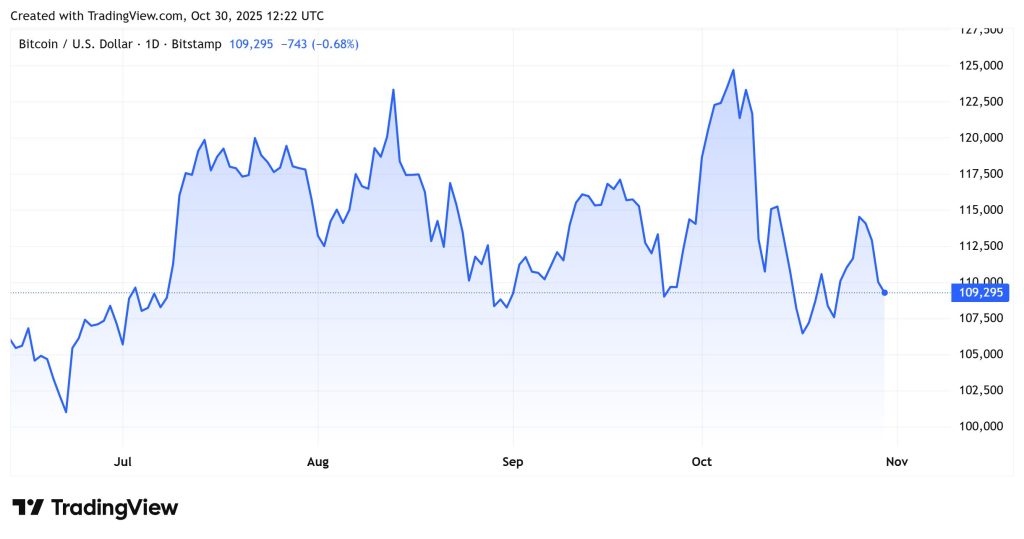Why Is Crypto Down Today? – October 30, 2025
The crypto market is down today, with the total cryptocurrency market capitalization falling by 3.0% to $3.78 trillion, according to data from CoinMarketCap. Meanwhile, the 24-hour trading volume sits at $192 billion, reflecting reduced activity as major cryptocurrencies turn red.
TLDR:
- The global crypto market cap fell 3.0% to $3.78T;
- 8 of the top 10 coins and most majors in the red;
- BTC dropped 3.5% to $109,373, while ETH slid 3.6% to $3,868;
- The Fed’s 25 bps rate cut and the end of quantitative tightening in December signal returning liquidity;
- Fear & Greed Index fell to 34 (Fear);
- BTC ETFs saw $470.7M outflows;
- ETH ETFs posted $81.44M outflows;
- AUSTRAC fined CryptoLink A$56,340 (US$37,085) for AML compliance failures.
Crypto Winners & Losers
At the time of writing, 8 of the top 10 cryptocurrencies by market capitalization have declined over the past 24 hours.
Bitcoin (BTC) fell 3.5%, now trading at $109,373, maintaining a market cap of over $2.18 trillion.

Ethereum (ETH) slipped 3.6% to $3,868, while BNB (BNB) dropped 0.5% to $1,107.
XRP (XRP) recorded a 4.4% decline to $2.54, and Solana (SOL) lost 3.9%, now priced at $190.92.
The biggest drop among the top 10 came from Dogecoin (DOGE), which fell 4.4% to $0.1872.
Despite the broader downturn, a few altcoins posted impressive gains. Aurora (AURORA) surged 65.1% to $0.08555, while Jelly-My-Jelly (JMJ) and Anvil (ANVL) rose 50.6% and 44.0%, respectively.
In contrast, PepeNode (PNODE) and BlockchainFX (BFX) topped the list of trending tokens despite declines of 19.7% and 5.7%, showing strong retail interest amid market volatility.
Meanwhile, Swiss-based asset manager 21Shares has filed with the US Securities and Exchange Commission (SEC) to launch a Hyperliquid (HYPE) exchange-traded fund (ETF) amid growing institutional appetite for altcoin-linked investment products.
The move came just weeks after Bitwise filed for a similar Hyperliquid ETF, underscoring intensifying competition among asset managers to capture investor demand for exposure to decentralized trading ecosystems.
The HYPE token powers Hyperliquid’s decentralized exchange, offering users fee discounts and serving as the gas token for its blockchain.
Bitcoin Holds Strong as Altcoins Lag Despite Fed Rate Cut and End of QT
The US Federal Reserve’s latest 25 basis-point rate cut unfolded as expected, sending Bitcoin briefly down to $109K.
However, the real market mover was the Fed’s confirmation that quantitative tightening (QT) will end in December, signaling the return of liquidity that could fuel risk assets. Analysts say this could set the stage for an “alt season,” though past patterns show such optimism often fades quickly.
In 2024, the first rate cut triggered a strong rally, but it fizzled by September, only to be reignited by Trump’s election victory later that year.
Despite those bursts of momentum, most altcoins have failed to reclaim their 2021 highs, while Bitcoin remains the only asset consistently trending upward.
Major tokens like ETH, SOL, and XRP remain more than 40% below their peaks, showing a market still in a consolidation phase.
Analysts view the current market as a reset rather than a crash, where liquidity is shifting rather than expanding. Solana and XRP both appear to be stabilizing, with record futures open interest near $3 billion each on CME.
Levels & Events to Watch Next
At the time of writing, Bitcoin trades at $109,295, down 0.68% on the day. The coin has been consolidating after failing to sustain momentum above $112,000 earlier this week. For now, BTC’s intraday range sits between $108,800 and $110,200, suggesting a cautious market tone.
A breakout above $111,800 could trigger a move toward $114,500 and potentially $118,000, where previous resistance zones lie. On the downside, failure to hold current support could open the door to $107,500, followed by a stronger support area around $105,000.
Meanwhile, Ethereum trades at $3,865, down 0.99% in the past 24 hours. The coin has been hovering near the $3,850–$3,900 zone after slipping from its weekly high near $4,100.
If ETH breaks above $3,950, it could attempt to retest $4,200 and then $4,400, where selling pressure has repeatedly capped rallies. However, a drop below $3,800 may lead to a deeper pullback toward $3,650–$3,700 in the short term.
Meanwhile, market sentiment has tilted slightly more bearish, with the Crypto Fear and Greed Index falling to 34, signaling “Fear.”
The index was at 39 yesterday and 43 a month ago, indicating a steady decline in confidence as traders remain cautious amid price volatility. The shift reflects ongoing uncertainty in the market, with participants holding back from aggressive positions while awaiting clearer signals from macroeconomic developments.
The US Bitcoin spot exchange-traded funds (ETFs) saw a sharp reversal on Wednesday, recording $470.7 million in outflows, according to data from SoSoValue.
The total cumulative net inflow now stands at $61.87 billion, with total net assets valued at $149.98 billion, representing 6.75% of Bitcoin’s market capitalization.
Among the funds, Fidelity’s FBTC led the outflows with $164.36 million, followed by Ark & 21Shares (ARKB) with $143.8 million, and BlackRock’s IBIT with $88.08 million. Grayscale’s GBTC also saw $65.01 million leave the fund.
The US Ethereum spot ETFs also recorded $81.44 million in outflows on Wednesday. The total cumulative net inflow now stands at $14.65 billion, while total net assets are valued at $26.60 billion, representing 5.58% of Ethereum’s market capitalization.
Among the nine ETFs, BlackRock’s ETHA was the only major fund to post gains, taking in $21.36 million. In contrast, Fidelity’s FETH saw the largest outflow at $69.49 million, followed by Grayscale’s ETHE with $12.83 million and Grayscale’s ETH with $16.18 million.
In contrast, the US Solana spot ETFs recorded $47.94 million in net inflows on Wednesday. The total cumulative net inflow now stands at $117.40 million, with total net assets reaching $432.29 million, representing 0.40% of Solana’s market capitalization.
Among the two listed ETFs, Bitwise’s BSOL led with $46.54 million in inflows, while Grayscale’s GSOL added $1.40 million. Total trading volume across both funds was $79.50 million for the day.
Meanwhile, Australian financial intelligence agency, AUSTRAC, slapped a AU$56,340 fine (US$37,085) on crypto ATM operator CryptoLink on Thursday.
The action comes after the regulator’s Crypto Taskforce, established last year, found late reporting of large cash transactions and “weaknesses” in CryptoLink’s AML rules.
You May Also Like

WOW Summit Partners with Hong Kong Sevens: Five Memorable Days of Web3, Sports, and Excitement!

Interview | Big tech is training AI on junk data: Intuition
